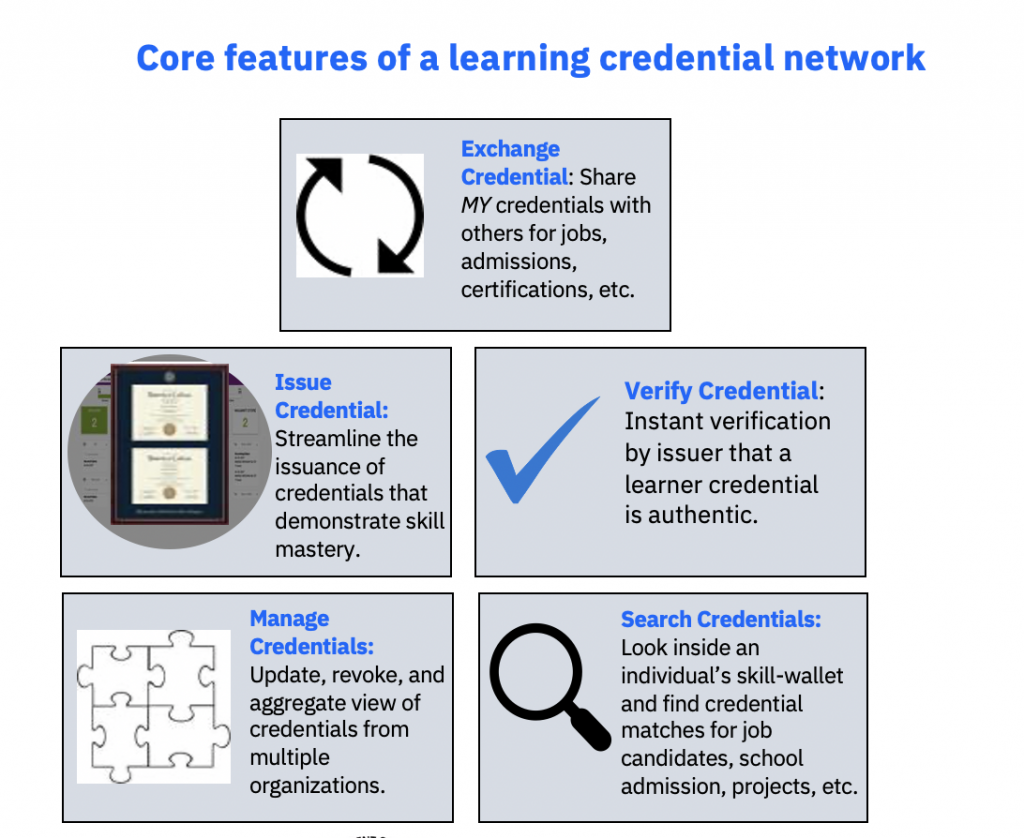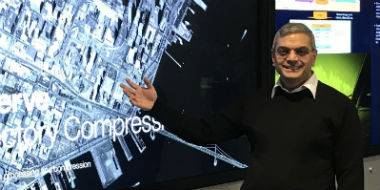Skills
Fixing the Mismatch Between Skills and Jobs: A Pilot Project to Test Learning and Employment Records
August 20, 2020 | Written by: Alex Kaplan
Categorized: Perspectives | Skills
Share this post:
 Over the last few years, employers have become less interested in which educational degrees people have and more interested in what actual skills they possess.
Over the last few years, employers have become less interested in which educational degrees people have and more interested in what actual skills they possess.
But there’s one challenge with that: It’s hard to know what skills someone truly has. IBM has come together with an important group of organizations to address this challenge. All are facing the same issues IBM faces: There’s a lot of obstructions and inefficiency in the talent market place. Technology can help us make this easier, as we hope to show in a pilot program in cooperation with the American Workforce Policy Advisory Board, led by the White House and the US Department of Commerce.
What’s the problem we hope to solve? You can look at resumes and at jobs or social media platforms, but that information is difficult to map to skills and sometimes unreliable . Studies have found that nearly a third of what’s posted is either “aspirational,’’ or simply not true. It’s also hard to tell from a resume what skills people have and how they map to the requirements of a particular job.
This method for filling jobs makes it tough for job seekers. They need an objective way to present information about their skills that makes them appealing candidates. Job seekers also need to properly receive full recognition for courses they have taken anywhere, or skills acquired in other nontraditional venues like coding camps.
Individuals also need a simpler way to understand what skills they require, and where to get them, to be hired for the jobs they want. One job does not always lead seamlessly to the next. Sometimes people want to change fields and to do that, need to reshuffle their skills and add some new ones. Sometimes they shift into job that are similar, but sometimes it is completely different. A platform or app that would let someone see what skills she is missing and where she can get them could be transformative—if, say, she is now a ballet dancer and wants to become a software programmer.
We need a reliable system for understanding people’s true skills. We can use artificial intelligence to scan the hundreds of thousands of applications submitted for many jobs, but many are chaotically written, and it can be hard to discern what skills match to what jobs. Neither the applicant material nor the job descriptions are written in a direct, specific, useful way. Nor are they easily aligned to the skills that would assure success.
A Path to the Future
In the pilot project IBM and its partners are conducting in league with the American Workforce Policy Advisory Board, which will be unveiled in September, we aim to make it easier for people to chart their own paths to the future. Our partners are the National Student Clearinghouse, Western Governors University and Central New Mexico Community College.
Creating a trusted platform requires a data set that can be shared all around—an interoperable data set. We don’t have that now.
Part of the root of the problem is the data itself. One organization might have the information, but it’s hard to share because there are proprietary databases involved and few generally agreed upon standards that define what this learning and employment record should look like. We need a set of standards for both applicants and job descriptions, and everything needs to be machine readable so technology can work its magic.
To provide privacy and security, the record must be built on a privacy protected blockchain infrastructure. People will have a permanent, verifiable record of their learning, certifications and skills. They will control the data and choose how it is shared. But they will not be able to manipulate it, nor will outsiders be able to hack it. Basically, everyone will have a digital wallet that contains their work and education info and they can share it where and how they please.
In the pilot, we will provide tools that make it easier for job seekers and employers to manage careers in cybersecurity. We will give students information about the skills they need to become a cybersecurity engineer and how to fill skills gaps they might have. The pilot will aim to give employers information on people looking for jobs who have the skills they are seeking.
Closing the Gap
How would this work? Let’s say you are one of the many restaurant workers let go because of the pandemic, and unlikely to soon find work in that industry. You have a set of skills and experiences, and they are reflected in your wallet. And let’s say you want to move into tech. You can inform the wallet—perhaps an app on your phone—what your new goal is. The app might then tell you that you have 30 percent of the needed skills, but here are education programs that can give you the remaining 70 percent.
Once you get that training, ideally the job will find you. That would be because you will have made your skills publicly available for employers to search—anonymously, of course, because blockchain allows for that.
In many fields there is a significant shortage of workers. Jobs are changing so rapidly it’s hard to keep up, for everyone. The fact that millions of people in the U.S. now are either unemployed or displaced has put fuel on the fire to help them find news jobs and careers.
While the transition to a skills-based economy was already underway, the pandemic has sped up this transformation. We need to make sure not only that we have a skills-acquisition and sharing system that functions and protects privacy, but that it doesn’t leave behind those who are less able to access or less comfortable using technology.
I believe this is a transformative use of technology that will change and improve peoples’ lives. And we must do it now, as it is urgently needed. With this pilot project, we and our partners are taking an important next step.

Alex Kaplan is Global Leader, Blockchain and AI for Industry Credentials, IBM Talent and Transformation.
A Day to Recognize and Honor the Vital Role of Nurses
Compassionate care is a big part of what we do as nurses. Our job has always been to help both patients and their families. We listen to questions and concerns, explain details of treatments and procedures, and lend support in many other ways. We have extensive skill sets in the health sciences, as well as […]
Jumpstarting Careers, Educational Opportunities with Blockchain
The world was a different place in 1979, the year I graduated from Albany State University, in Albany, Ga. When I began my career that year at IBM, I was testing diskettes – a technology that’s foreign to most college students today. Over the course of a 39-year career, I’ve seen the technology sector undergo […]
Continuously Learning and Reinventing, This Man is Connecting Everything to the Internet
Dinesh Verma is an IBM Fellow, the company’s pre-eminent technical distinction granted in recognition of outstanding and sustained technical achievements and leadership in engineering. Dinesh has worked in IBM Research for nearly 25 years, holds more than 150 patents, is a member of the IBM Academy of Technology, and heads a team that is focused on […]


